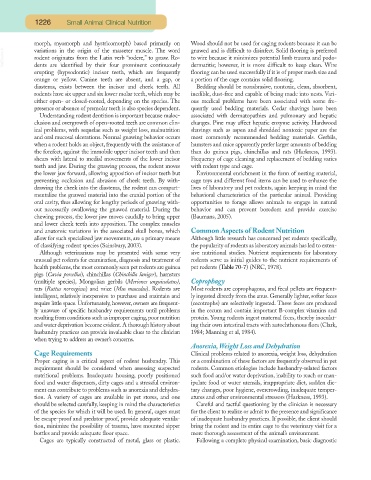Page 1176 - Small Animal Clinical Nutrition 5th Edition
P. 1176
1226 Small Animal Clinical Nutrition
morph, myomorph and hystricomorph) based primarily on Wood should not be used for caging rodents because it can be
VetBooks.ir variations in the origin of the masseter muscle. The word gnawed and is difficult to disinfect. Solid flooring is preferred
to wire because it minimizes potential limb trauma and podo-
rodent originates from the Latin verb “rodere,” to gnaw. Ro-
dermatitis; however, it is more difficult to keep clean. Wire
dents are identified by their four prominent continuously
erupting (hypsodontic) incisor teeth, which are frequently flooring can be used successfully if it is of proper mesh size and
orange or yellow. Canine teeth are absent, and a gap, or a portion of the cage contains solid flooring.
diastema, exists between the incisor and cheek teeth. All Bedding should be nonabrasive, nontoxic, clean, absorbent,
rodents have six upper and six lower molar teeth, which may be inedible, dust-free and capable of being made into nests. Vari-
either open- or closed-rooted, depending on the species. The ous medical problems have been associated with some fre-
presence or absence of premolar teeth is also species dependent. quently used bedding materials. Cedar shavings have been
Understanding rodent dentition is important because maloc- associated with dermatopathies and pulmonary and hepatic
clusion and overgrowth of open-rooted teeth are common clin- changes. Pine may affect hepatic enzyme activity. Hardwood
ical problems, with sequelae such as weight loss, malnutrition shavings such as aspen and shredded nontoxic paper are the
and oral mucosal ulcerations. Normal gnawing behavior occurs most commonly recommended bedding materials. Gerbils,
when a rodent holds an object, frequently with the assistance of hamsters and mice apparently prefer larger amounts of bedding
the forefeet, against the immobile upper incisor teeth and then than do guinea pigs, chinchillas and rats (Harkness, 1993).
shears with lateral to medial movements of the lower incisor Frequency of cage cleaning and replacement of bedding varies
teeth and jaw. During the gnawing process, the rodent moves with rodent type and cage.
the lower jaw forward, allowing apposition of incisor teeth but Environmental enrichment in the form of nesting material,
preventing occlusion and abrasion of cheek teeth. By with- cage toys and different food items can be used to enhance the
drawing the cheek into the diastema, the rodent can compart- lives of laboratory and pet rodents, again keeping in mind the
mentalize the gnawed material into the cranial portion of the behavioral characteristics of the particular animal. Providing
oral cavity, thus allowing for lengthy periods of gnawing with- opportunities to forage allows animals to engage in natural
out necessarily swallowing the gnawed material. During the behavior and can prevent boredom and provide exercise
chewing process, the lower jaw moves caudally to bring upper (Baumans, 2005).
and lower cheek teeth into apposition. The complex muscles
and anatomic variations in the associated skull bones, which Common Aspects of Rodent Nutrition
allow for such specialized jaw movements, are a primary means Although little research has concerned pet rodents specifically,
of classifying rodent species (Sainsbury, 2003). the popularity of rodents as laboratory animals has led to exten-
Although veterinarians may be presented with some very sive nutritional studies. Nutrient requirements for laboratory
unusual pet rodents for examination, diagnosis and treatment of rodents serve as initial guides to the nutrient requirements of
health problems,the most commonly seen pet rodents are guinea pet rodents (Table 70-7) (NRC, 1978).
pigs (Cavia porcellus), chinchillas (Chinchilla laniger), hamsters
(multiple species), Mongolian gerbils (Meriones unguiculatus), Coprophagy
rats (Rattus norvegicus) and mice (Mus musculus). Rodents are Most rodents are coprophagous, and fecal pellets are frequent-
intelligent, relatively inexpensive to purchase and maintain and ly ingested directly from the anus. Generally lighter, softer feces
require little space. Unfortunately, however, owners are frequent- (cecotrophs) are selectively ingested. These feces are produced
ly unaware of specific husbandry requirements until problems in the cecum and contain important B-complex vitamins and
resulting from conditions such as improper caging,poor nutrition protein. Young rodents ingest maternal feces, thereby inoculat-
and water deprivation become evident.A thorough history about ing their own intestinal tracts with autochthonous flora (Clark,
husbandry practices can provide invaluable clues to the clinician 1984; Manning et al, 1984).
when trying to address an owner’s concerns.
Anorexia,Weight Loss and Dehydration
Cage Requirements Clinical problems related to anorexia, weight loss, dehydration
Proper caging is a critical aspect of rodent husbandry. This or a combination of these factors are frequently observed in pet
requirement should be considered when assessing suspected rodents. Common etiologies include husbandry-related factors
nutritional problems. Inadequate housing, poorly positioned such food and/or water deprivation, inability to reach or man-
food and water dispensers, dirty cages and a stressful environ- ipulate food or water utensils, inappropriate diet, sudden die-
ment can contribute to problems such as anorexia and dehydra- tary changes, poor hygiene, overcrowding, inadequate temper-
tion. A variety of cages are available in pet stores, and one atures and other environmental stressors (Harkness, 1993).
should be selected carefully, keeping in mind the characteristics Careful and tactful questioning by the clinician is necessary
of the species for which it will be used. In general, cages must for the client to realize or admit to the presence and significance
be escape-proof and predator-proof, provide adequate ventila- of inadequate husbandry practices. If possible, the client should
tion, minimize the possibility of trauma, have mounted sipper bring the rodent and its entire cage to the veterinary visit for a
bottles and provide adequate floor space. more thorough assessment of the animal’s environment.
Cages are typically constructed of metal, glass or plastic. Following a complete physical examination, basic diagnostic

